Welcome back to The Journey, where we track the development of prospects as they excel in junior, make the NHL, and push towards stardom.
This week is the second part in a series gleaning insights about prospects and young players from the Frozen Tools Player Usage Charts, which can be found under the Advanced Stats section of every player's profile.
Read Part One if you haven't already for further context about how to read the charts.
Colorado
First up are Alex Newhook and the Avalanche. The speedy Newhook is currently on a lowly 27-point pace and has not yet blossomed into the second-line center many poolies hoped he would become this year with the departure of Nazem Kadri. In terms of CorsiFor% relative, a stat that measures a player's effectiveness in driving shot attempts relative to his teammates, Newhook (dark orange bubble in the middle) is the worst on the team along with the ageing Erik Johnson. That despite being sheltered from other team's best players.
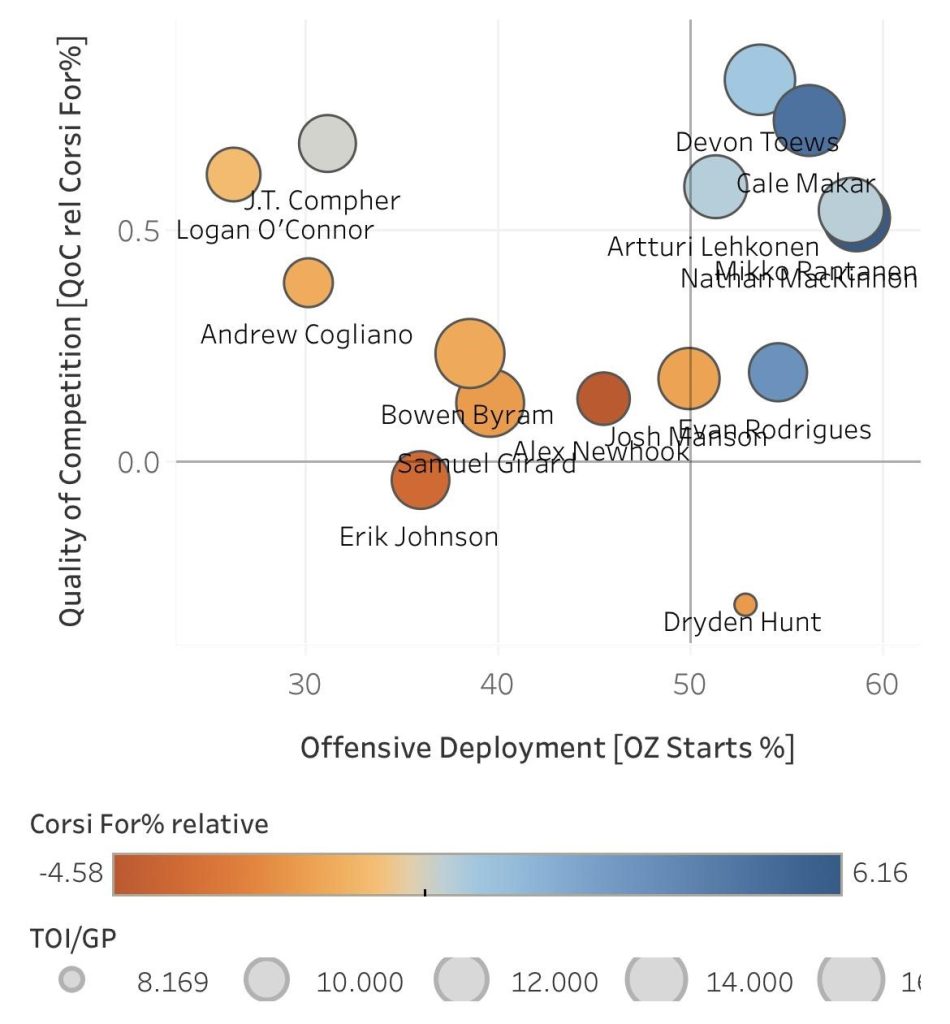
Newhook is still seeing time on the top power-play unit with Nathan MacKinnon and Cale Makar, which is promising, and he is still over a full season away from his Breakout Threshold, so expectations should be kept in check for the moment. But it is still concerning to see him struggling so badly relative to his teammates despite being so heavily sheltered.
That said, this is a great opportunity to roll the dice on Newhook, who remains a skilled future top sixer on a powerhouse team.
Dallas
Moving south to Dallas, their chart looks like a reverse image of Colorado's: whereas the Avalanche's top stars are in the top right quadrant (hard competition, lots of offensive zone face-offs), the Stars' big guns are being extremely sheltered while young players like Wyatt Johnston and Ty Dellandrea are facing other teams' best players.
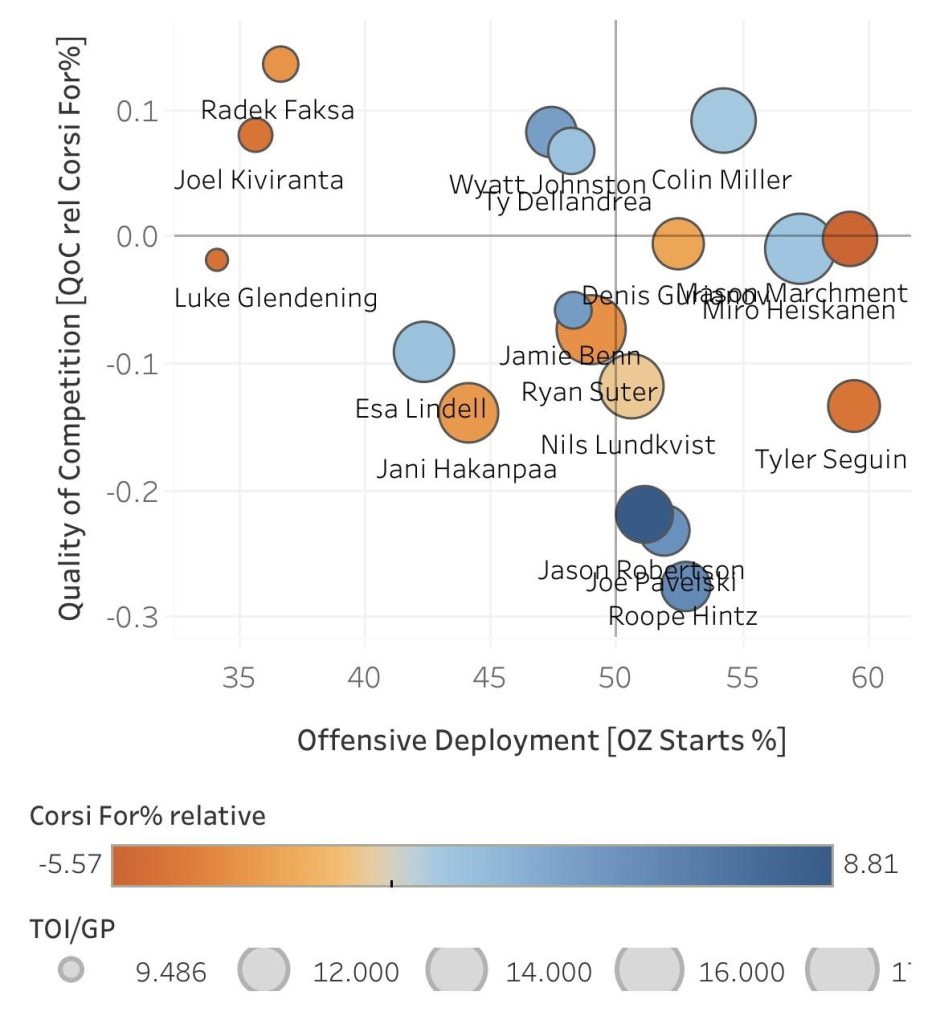
That Robertson line is absolutely dominating play, and the Johnston – Dellandrea – Jamie Benn line is also thriving, so it's hard to argue with results. But it's odd to see a team's top line so heavily sheltered. Those dark blue bubbles will likely float closer to the top as games accumulate and other teams find more success matching lines with Dallas. But they are absolutely feasting on other teams right now.
Although Johnston only has six points in 20 games, he is clearly having a significant impact on this team already. Outside of the Robertson line, Johnston is already the best play driver the Stars have—and again, he is getting these results against high-quality competition. Very impressive for a kid who jumped to the NHL straight out of junior after leading the entire CHL (which includes the WHL, OHL, and QMJHL) in scoring last year by a fair margin with 124 points in only 68 games.
Those totals are reminiscent of Robertson's D+2 numbers when he also led the CHL in scoring with 117 in 62 except that Johnston managed that production a year earlier after missing an entire season. Further, Johnston is already in the NHL in his D+2 while Robertson spent his D+3 year in the AHL before finding immediate success in the NHL the following year.
Here are how the two compare on Hockey Prospecting:
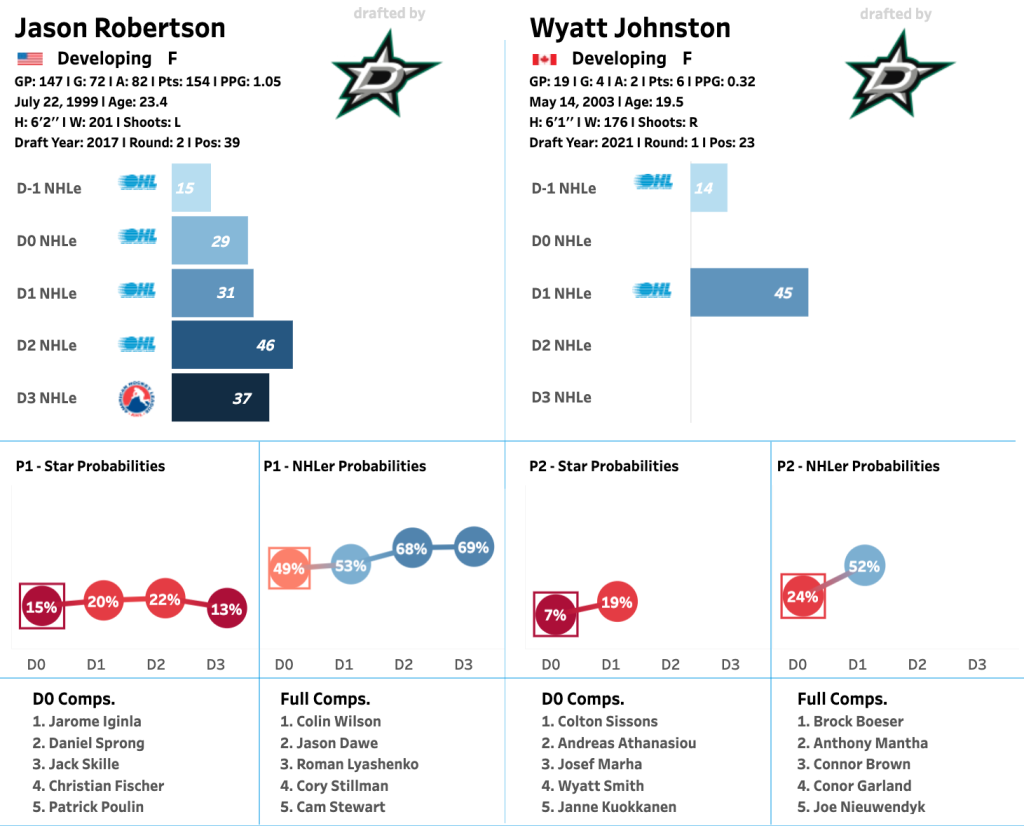
Johnston lost his critical draft year due to Covid cancellations and has been forced into NHL action early because of the NHL-CHL agreement that prevents him from playing in the AHL as a teenager. All that said, Johnston's trajectory looks a LOT like Robertson's; if anything, it looks even a bit stronger in that he is hitting similar heights at a younger age.
Given Robertson is now considered one of the top five fantasy forwards in the league, don't worry about Johnston not lighting up the scoresheet yet. He might take a couple seasons to get going, but there is clearly a special player here.
Detroit
Next we'll take a look at Detroit, a team flush with interesting young talent. The Red Wings chart is a bit visually chaotic but there are a few key insights here.
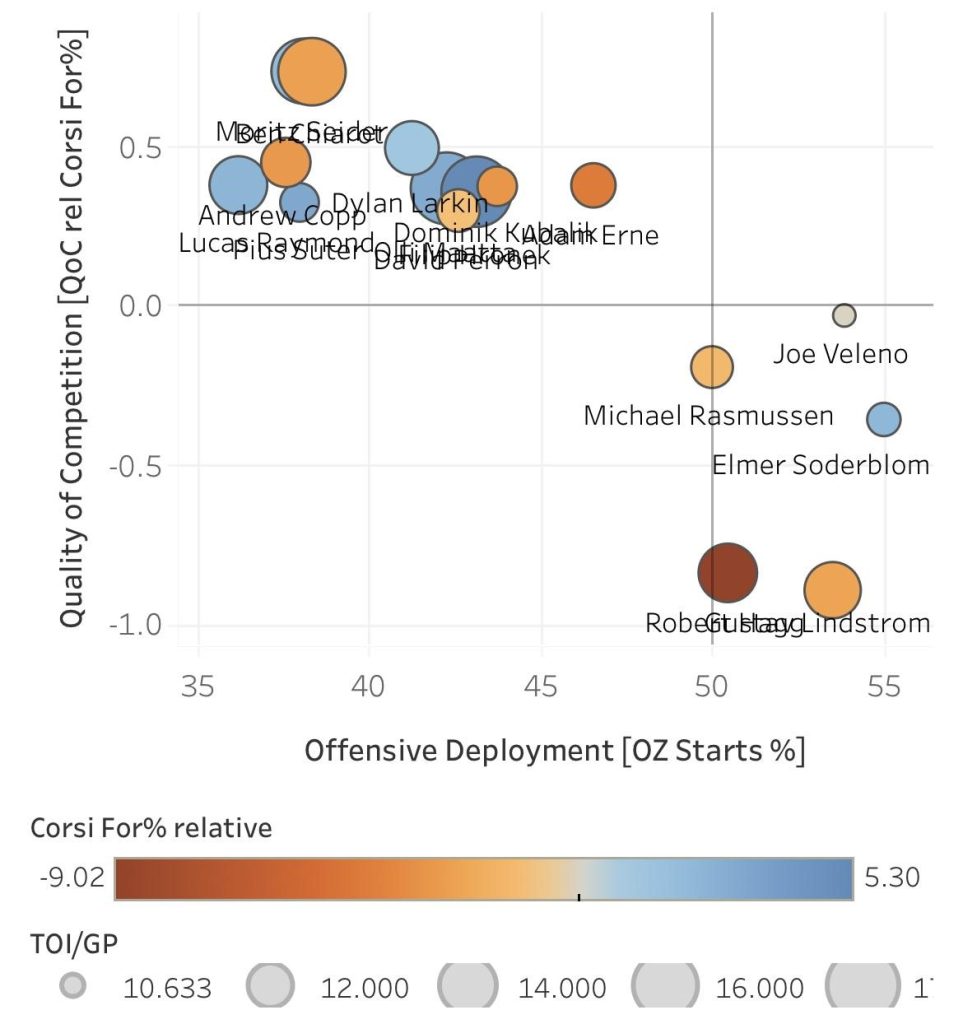
Managers have been lamenting Moritz Seider's slow start to the year (nine points in 19 games) but digging deeper into his numbers, those concerns feel overblown. As you can see above—his is the blue bubble in the top left nestled against Ben Chiarot's similarly sized orange bubble—Seider is taking on the hardest minutes on this team and doing well. Keep in mind he is only in his second year.
Plus, though Seider is currently on a 40-point pace, down from the 50 points he put up as a rookie, it won't take much for his 2022-23 production to pop back up: a couple more games like his three-assist night against Columbus last week and he will be back on track for 50+. He still has a firm grasp on the top PP and is putting up shots, hits, and blocks at a similar rate to last year. If his manager in your league is waffling even slightly, try to acquire this guy before his value climbs back up to last year's heights.
The other Red Wing whose deployment jumps off this chart is Lucas Raymond. What is he doing with the least offensive zone starts on this team? That is the opposite deployment one would expect for a 20-year-old offensive dynamo. He is starting most of his shifts in the defensive zone against other teams' top players and is incredibly still managing a 52-point pace.
The return of Tyler Bertuzzi in mid-November has put the Wings' lines in a bit of a blender. The Raymond-Bertuzzi-Dylan Larkin line has been reunited several times, which is promising, though last game Andrew Copp replaced Larkin with less-than-ideal results (32% CorsiFor as a line). Raymond's fantasy owners will be hoping to see his 34% Offensive Zone starts increase dramatically as the season continues. It is difficult to score when you start out 180 feet from the opponent's net most times you step onto the ice.
The positive takeaway here is that Raymond is still scoring and driving play despite this challenging situation; that means there is room to grow from here. This is a player with potential to consistently exceed a point per game, so like Seider, buy in now while you still can.
Edmonton
Over in Edmonton, scoring totals suggest that Tyson Barrie (12 points in 20 games) is thriving at the expense of the struggling Evan Bouchard (six in 20). But a look at the Edmonton chart suggests otherwise.
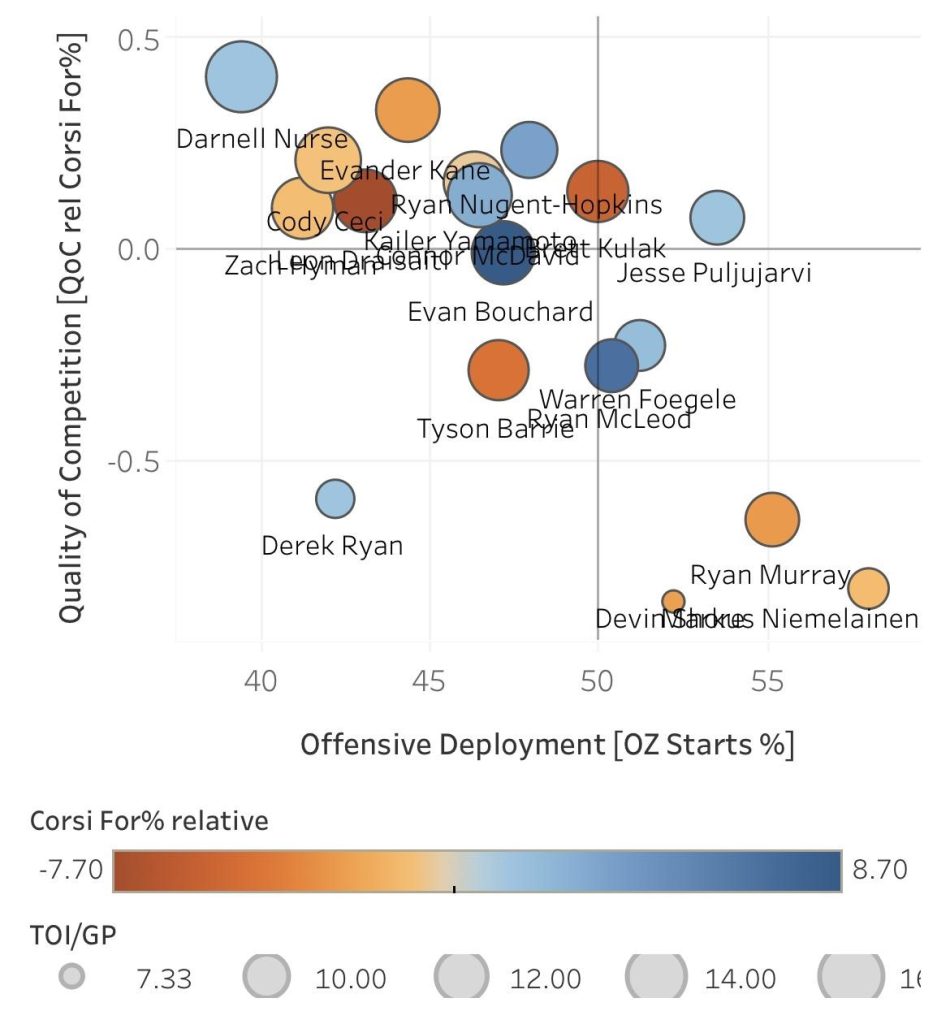
Bouchard, the dark blue bubble directly above Barrie's orange one, has the best relative play driving numbers on this team. Despite his superior point totals and heavier sheltering, Barrie is struggling. He is also pointless in his last four games, so perhaps the tides are already shifting.
Even in redraft leagues, and especially keeper and dynasty, Bouchard is still the one to own here. He has a noticeable calm with the puck and distributes well with his excellent vision and handling. Although Barrie has another year on his contract after this one, it's just a matter of time before Bouchard is running this potent Oilers PP.
New Jersey
Skipping over a few teams who are light on prospect insights, let's take a look at the Devils. Who do you notice right away?

Fabian Zetterlund right? His dark blue bubble in the top left corner indicates that the rookie surprisingly has the best play-driving metrics on this team in the early going despite taking on other teams' best players and not receiving many offensive zone starts. That's a testament to the chemistry he has discovered alongside a rejuvenated Tomas Tatar and a now-elite Nico Hischier.
Zetterlund has seemingly come out of nowhere to post 10 points in 16 games—good for third in rookie scoring in what is a very tight race so far, and in fewer games than anyone else in the top ten. Beyond points, Zetterlund also fares very well in Dobber writer Grant Campbell's Player Game Ratings, which combines a number of factors to assess how well players are impacting games.
Zetterlund is currently the top rookie in the league by Campbell's Player Game Rating—a metric that combines a number of factors to describe a player's overall impact on a game.
While 16 games is a small sample size, these early results are promising—especially for a player who put up a point-per-game season in the AHL last year as a rookie. His numbers back in Sweden left something to be desired but he appears to be a late bloomer who is becoming an integral part of New Jersey's early success this year.
Thanks for reading! Follow me on Twitter @beegare for more prospect content and fantasy hockey analysis.

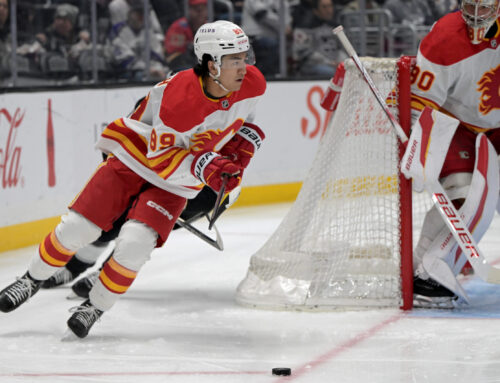

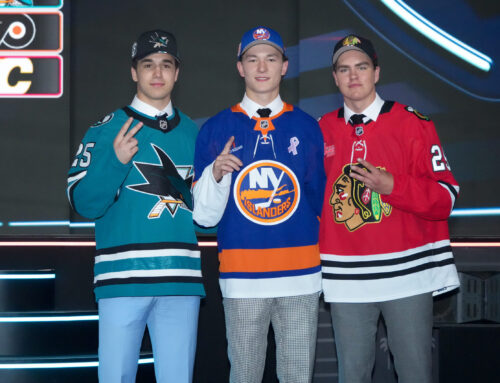
 FLA
FLA CHI
CHI NYR
NYR PIT
PIT L.A
L.A COL
COL UTA
UTA BOS
BOS BUF
BUF SEA
SEA NYI
NYI VAN
VAN MIN
MIN TOR
TOR
